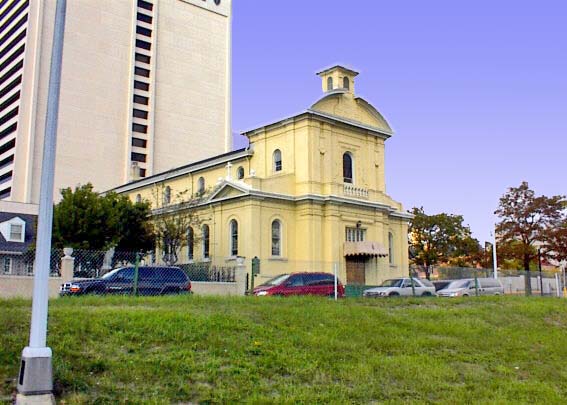

This is the yellow-hued church that is very visible when you exit the Chrysler Expressway in downtown Detroit, or drive west on East Jefferson toward the Renaissance Center. It is one of the most frequently seen church in downtown Detroit. It is also Detroit's first Italian Catholic church. Shortly after 1900, immigrants from Sicily and southern Italy settled in northeast Detroit. They began to worship at Sts. Peter and Paul on East Jefferson, but in 1907, Father Giovanni Boschi arrived from Italy and sought to establish an Italian parish here. In 1908, Bishop Foley gave him permission to do so and named the parish La Chiesa Della Sacra Famiglia or the Church of the Holy Family.
In 1909, construction began on a modest Italian Renaissance-style, basilica-type church. At that time, the street in front of the church was Hastings, not the Chryusler Expressway service drive. There is a central entrance pavilion with a segmented pediment that frames a limestone medallion. Then there is a triangular pediment and then, even more elevated on the front of the church, is a rounded arched belfry. The stained glass windows are also attractive and distinctive. The aisle windows date from the original construction and illustrate a variety of Catholic scenes, including several displaying popular Italian saints. The clerestory windows date from 1980 and show more scenes from the life of Christ. This is a brick church. Originally, the bricks were painted in gray but now they are taupe with the trim in white. The church includes at least five alters, each depicting the Blessed Virgin Mary with symbols of specific towns in Sicily.
Compared to other downtown churhes, the size of this building is very small reflecting the size of the Italian migration stream in Detroit. Census 1910 enumerated just over six thousand Detroit residents who reported Italy or Scily as their country of birth. Italy, as an origin country, was outranked by the leading sending nations: Canada, German, Russia, Austria, England and Ireland. In 1910, the number of persons born in Canada or in Germany was more than eight times the number born in Italy. More than one hundred years after its founding, this parish is in operation with an Italian language Mass said every Sunday.
The authors of the 2012 book, Detroit's Historic Places of Worship, prsent marvelous pictures of the interior of this church. They also reports that the architects modeled this building after, perhaps, both Santa Susanna Church in Rome and the Church of San Marco in Florence. We show pictures of those church so that you can make your own comparison.
Architect: Edward A. Schilling and Edward C. Van Leyen
Architectural Style: Seventeenth century Italian Baroque style typically of
the church built in that era in southern Italy and Sicily.
Date of Completion: 1910
Website for this congregation: http://www.parishesonline.com/Scripts/HostedSites/org.asp?p=1&ID=15871
For additional information, please see: Marla O. Collum, Barbara E. Krueger and Dorothy Kostuch, Detroit's Historic
Places of Worship. Detroit: Wayne State Univrsity Press, 2012
Michigan Registry of Historic Sites: P25140, Listed February 16, 1989
Michigan Historical Marker. Erected October 22, 1990. This marker is clearly
visible at the front of the church along the Chrysler Expressway service drive.
Photo: October, 2002, Ren Farley
Use in 2013: Catholic Church
Description Updated: March, 2013